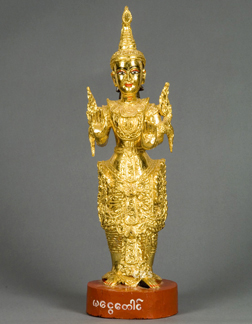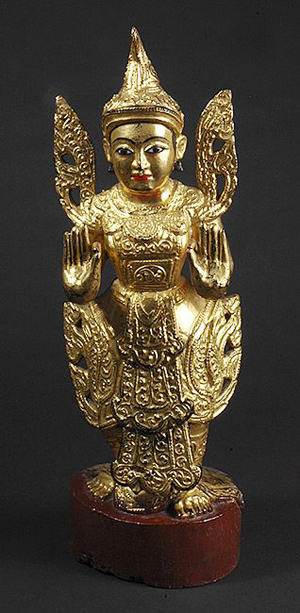
Twelve kilometres north of Monywa, on the Shwebo road, the town of Ahlone celebrates its festival from the 7th day of the waning moon of the month Tabaung until the new moon. The heroine of these festivities is Ma Ngwe Taung (Miss silver Wings) who is also called Ma Phyulwa (Miss White and Pure). She was a daughter of Ahlone Boedaw, who was a minor Indian prince who came down into Burma through Tamu or Kalei Myo. His history would have been forgotten, were it not for the love story of Ma Ngwe Taung. The young girl became infatuated with U Min Kyaw, the notorious drunkard, who was hardly an ideal son-in -law for a Maharaja, even if a not very important one. It is not difiult to imagine his irritation at the stubbornness of his little daughter who surely deserved a better match. U Min Kyaw’s indiscretions proved him right. This womanizer soon lost interest in Ma Phyu Lwa in favor of the embraces of Shin whose father was a manufacturer of a famed toddy or palm wine. Maharaja’s family thought their daughter would forget her one-time suitor and so the years went by.
One night she heard from a nearby hill, the music of a harp. Ma Ngwe Taung ran until she was out of breath believing that she had heard U Min Kyaw. Once there in the dark she threw herself into the harpist’s arms. Unfortunately it was her brother, Shwe Kyauk Soung who snubbed her. Shameful of this misunderstanding, Ma Ngwe Taung jumped off a cliff. Before giving up her soul she cursed all unfaithful men. All men possessed by her spirit would be perpetually unsatisfied in love and never find happiness even if they had as many mistresses as hairs on their heads. At least, as long as they married them. Ma Ngwe Taung was chosen because of this tragic fate to be a Nat. Any men she falls for will be abandoned to the agonies of unhappy love. Of all the female nats she is the only one whose victims by the leik-pya-taik ceremony do not even get to become her brother or son but only her husband.

Indeed, Ahlone holds much appeal for pilgrims who ask Ma Phyu Lwa to give them the opportunity to have as many mistresses as hairs on their head. The festival appeals also to pilgrims wishing to control or to cure skin disease with lustral water on offer there. Here lepers gather not too far from the temple. The temple itself situated not far from the railway line. Its architecture is not very noteworthy. The corrugated iron of the roof is as rusty and decrepit as all else seems to be. As at all great pwe, merchants have built bamboo stalls about which are parked innumerable oxcarts. The eve of festival a torch-lit procession arrives in the dark of the night at the hill where she met her fate. It is not particularly high and it is difficult to imagine the maiden falling to her death from it.
The actual homage to Ma Shwe Taung does not start till the 3rd or 4th day of the festival, after the offerings had been given to her grandfather and grandmother. As she was of Hindu origin she cannot be offered meat, neither beef nor pork, and alcohol is banned in remembrance of U Min Kyaw’s involvement. Traditional offerings like white flowers, Indian sweets, fried bananas, nine fried fishes with scales and nine rice cakes coloured red and white are common. At the temple of Ahlone Shwe Let Pan, the elder brother with his wife La Bo Shin Daw sit on the throne, but Ma Ngwe Taung cannot be found. Though one cannot help but be moved by her disappointment in love, the temple is dedicated to the elders who blamed her. The moral of this tale lies in the hands of the listener.

